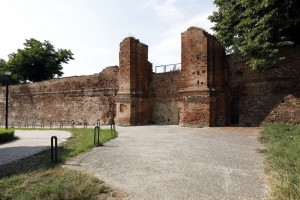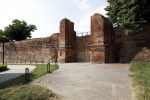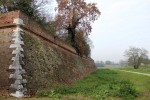The Porta Romana or Porta di San Giorgio
Before the construction of Porta Paola (1612), the gate called Porta di San Giorgio (later Porta Romana) was the main entry point in the south of the city, preferred thanks to its proximity to the River Po and the bridge that connected it with the suburban church of San Giorgio.
Historical notes
The current ruins are all that remains of the architectural complex that until the end of the sixteenth century overlooked the main southern entrance of the city, situated in front of the church of San Giorgio (Ferrara’s first cathedral). Beyond the Po di Volano, the ruins can be reached via a bridge: originally made from wood, this was centred in line with the Porta and rebuilt a number of times - first in brick in 1682 and then in iron between 1891 and 1894, when it was also moved further to the east. Partially destroyed in the bombings of 1944, the Porta was rebuilt once again in 1950 in reinforced concrete, and the surviving statues depicting the city's holy saints were positioned on top of it: Giorgio, Maurelio, Rocco and Filippo Neri, created in 1786 by Veronese sculptor Gaetano Cignaroli. They were restored in 1994 by the Ferrara Civic Museums of Ancient Art and the Ravenna Superintendency of Architecture.
For almost two centuries, popes, princes, prelates and other illustrious characters made their grand entrance to the city via this passageway. In order to protect the fifteenth-century Porta di San Giorgio (known as Porta Romana from 1798 onwards), Dukes Ercole II and Alfonso II d'Este ordered the construction of a new bastion, between 1557 and 1563, which was partially destroyed in 1893 to create a toll barrier. It was torn apart once again between 1952 and 1958 in order to build a filling station, useful for vehicles heading to the increasingly populous suburb.
The gate was transformed into a monumental ‘Prospettiva’ arch in the 1780s, and was further embellished in 1857 to make its axial centrality with the bridge even more appealing for Pope Pius IX's visit to Ferrara. However, the changes and disasters that befell the structure at the end of the nineteenth century led to the functional decentralisation of the building, resulting in architectural damage. Today's Via Daniello Bartoli was constructed in place of the old bridge.
Bibliography
Fototeca
Related Themes
Compiling entity
- Assessorato alla Cultura e al Turismo, Comune di Ferrara



